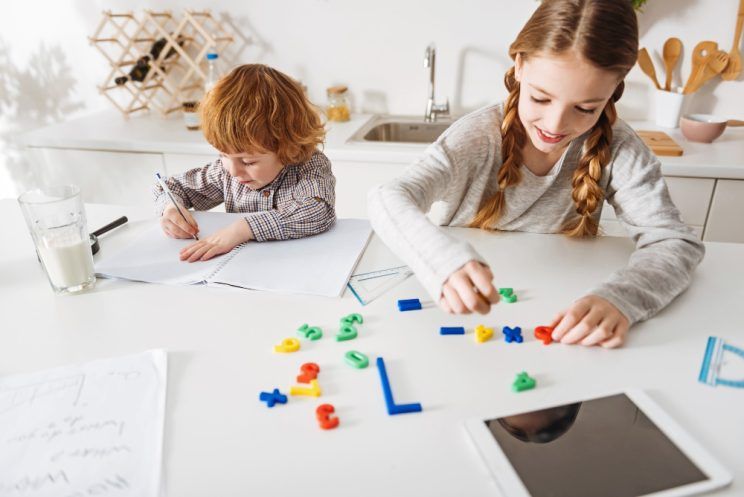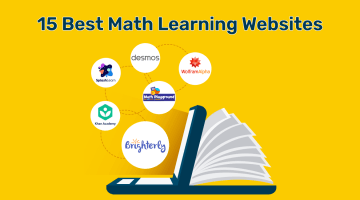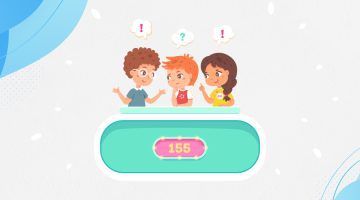20 Fun Math Activities For Your Kids (Elementary, Middle & High School)
reviewed by Jo-ann Caballes
Updated on November 4, 2025
82% of US students fear math. Math is a critical life skill, but kids dislike it – and their grades have been getting worse since the COVID-19 pandemic began. Using fun and engaging math activities is key to ensuring your children perform well. Here, we cover 20 of the most exciting and fun math activities that can make math thrilling – these fun math games are for the classroom and home!
Fun math activities for elementary students
- Sing math songs
- Use drawings or pictures
- Enlist an expert tutor
- Cook with your kids
- Combine with coloring
- Use equal groups in math activities
- Play math-based board games at home
Fun math activity #1: Sing math songs
Singing is one of the best ways to cement knowledge in young children. Not only is it a fun activity, but it also helps kids exercise their “memory muscle”. And yes, it can be used to reinforce math learning too!
There’s a reason our ABCs are recited in a memorable tune. And who remembers classic tunes from childhood like Ba Ba Black Sheep and Mary Had a Little Lamb?
There are countless math songs that you can teach your kids. You can help them understand how to add, subtract, multiply and divide through the power of song. Can’t find a song you like? Why not make up your own!
This can form a fun math game for the classroom or home.
Fun math activity #2: Use drawings or pictures

Elementary school kids, particularly those in grades 1 and 2, are primarily visual learners. So, what better way to help them understand basic math concepts than with picture-based elementary math activities?
Want to teach your kids addition and subtraction? Drawing something like an apple or a shirt, then getting them to cross some out or add more, is a great way to start.
Want to challenge your kids further in grades 3 and 4? Our Lines of Symmetry worksheets allow kids to flex their skills by completing the symmetrical half of an image.
Fun math activity #3: Enlist an expert tutor

There are plenty of math activities for kids you can do at home. But it also helps to tap into expert help.
Brighterly has been teaching kids from 1st to 10th grade in an engaging and interactive manner for years. We focus on getting kids to understand math concepts, not just memorize them.
We use a diagnostic math test to understand the gaps in your kid’s knowledge. From that, we create personalized, interactive programs that improve their knowledge – all while having fun.
We give children the knowledge they need for seven different grades – so no matter which stage they’re at, we can help.
Fun math activity #4: Cook with your kids
Teach your kids two skills for the price of one with cooking! This is a great creative math activity.
Learning to cook basic recipes will set your child up for life. It can also help them understand measurements and fractions. Both of these concepts are key at the early elementary stage.
Measuring out ingredients for baking cookies helps kids hone their math skills without even thinking about it. For older elementary kids, try weighing out ingredients for more complex meals, e.g., 250g of diced chicken.
You can cook or bake a range of pastries or meals, including:
- cookies
- cakes
- rice krispie cakes
- chicken curry with rice
- spaghetti and meatballs.
Stick to basic recipes to avoid any kitchen disasters…
Fun math activity #5: Combine with coloring
Coloring is an activity your kids can lose themselves in. It also builds a lot of cognitive skills. It enhances creativity, hand-eye coordination and fine motor skills.
Boost the benefits of this activity by incorporating math for the perfect elementary math activities!

Our Pre-K Color and Count math worksheet combines color and math for a fun way to enhance learning. Kids need to color the number of animals, shapes or objects to match the number on the sheet.
Fun math activity #6: Use equal groups in math activities
Rather than simply teaching children fractions, use real-world applications like equal groups. These examples help kids to visualize math concepts.
It’s much more engaging for a kid to work out how to split a cookie between four people than to simply write out the math.
Our worksheets are designed to improve kids’ math skills in a fun and engaging way. We don’t just teach kids how to memorize sums.
We provide visually and mentally engaging ways for them to understand math concepts via fun math activities for children.
Fun math activity #7: Play math-based board games at home
The best types of fun math activities for kids are ones where kids flex their skills without even realizing it. Incorporate math-based games into family game nights or weekends for an effortless way to reinforce mathematical concepts.
Monopoly is a great game for addition and subtraction of three, four and five-digit numbers. It also helps kids to understand money and currency.
Not only is this a super-fun way for kids to practice their math skills, but it is proven to enhance math ability in three-to-nine-year-olds. The study identified Monopoly and Othello as examples of great math-boosting board games.
Check out our blog on the best math board games for your kids, which include:
- Fish Stix
- Prime Climb
- High Seas Addventure
- and more!
Fun math activities for middle school
- Utilize pattern worksheets
- Play math card games
- Create a life-sized coordinate plane
- Embed math into daily chores
- Relate math to real-life scenarios
- Challenge them to math-based word problems
Fun math activity for middle school#1: Utilize pattern worksheets
As your kid progresses through middle school, they’ll be introduced to more complex challenges. Recognizing patterns is a key math skill, and our Patterns worksheets make this one of the most fun and engaging math activities.
Our sheets feature progressive difficulty levels, so you can introduce your kids to patterns at the elementary stage. They utilize real-life objects, engaging designs and a variety of patterns to keep kids engaged. These are just some of our fun math activities for middle school kids!
What’s more, they include additional creative math activities that require your kids to create their own patterns, reinforcing the learning and boosting their creativity.
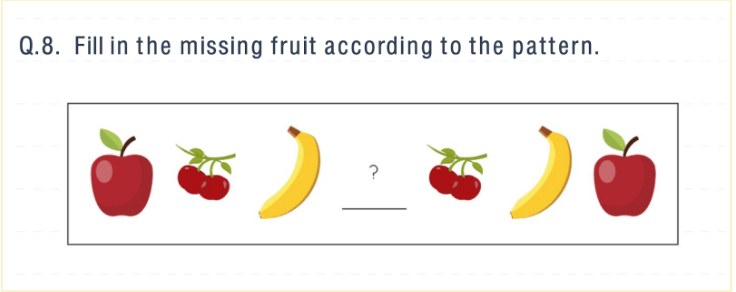
Fun math activity for middle school#2: Play math card games
Card decks can offer fun, visual and entertaining math activities. There are a lot of different math learning activities you can play with a deck depending on your child’s level and grade.
Elevens is a great game for teaching addition. You just lay out nine cards in a grid, with three cards per row. Your kid just needs to use the available cards to add up to 11.
Once your kid has mastered elevens, you can move on to more complex games like blackjack (or 21s, if you prefer not to use gambling language!). You can incorporate card games with more challenging rules, like solitaire, as they progress through elementary school.
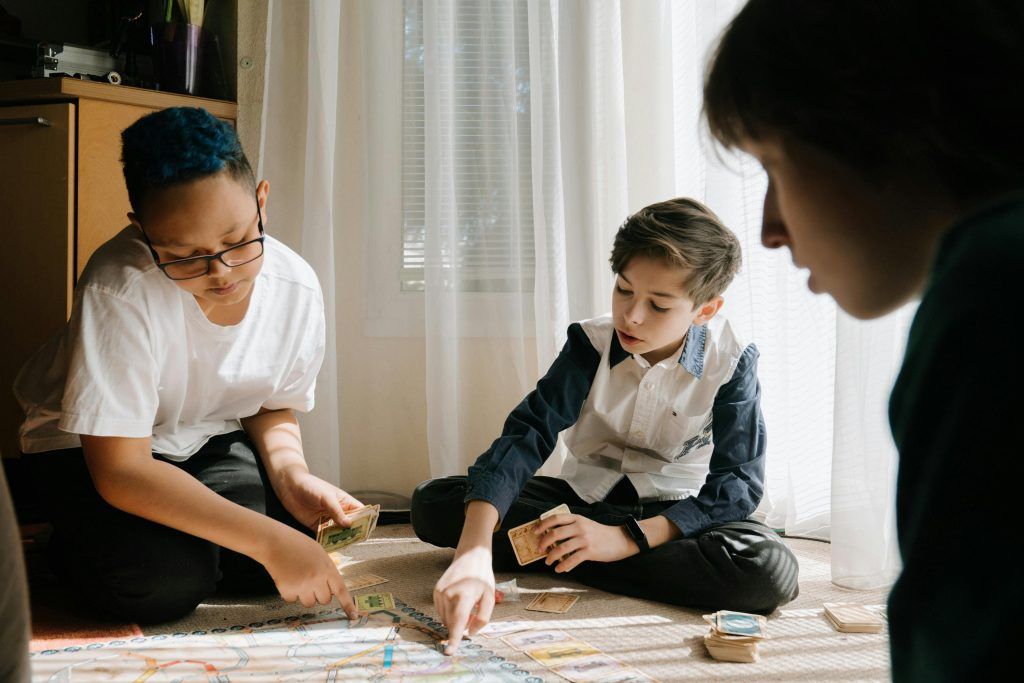
Fun math activity for middle school#3: Create a life-sized coordinate plane
One element of teaching that gets lost as our kids grow is kinesthetic learning. Kids are less physically involved in education as they grow. And for some, that’s how they learn best.
Bring graphs to life by creating a life-sized coordinate plane! This can be done in the classroom, at home or as an outdoor math activity. Your kid(s) will be real-life plots on the graph while they understand how graphs work and how to plot their X and Y axes.
You could use pre-set plots and ask your kids to place themselves in an exact position. You could also make it more light-hearted by giving each quadrant an aspect (such as smart, funny, energetic and loud) and asking your kids to plot their own position.
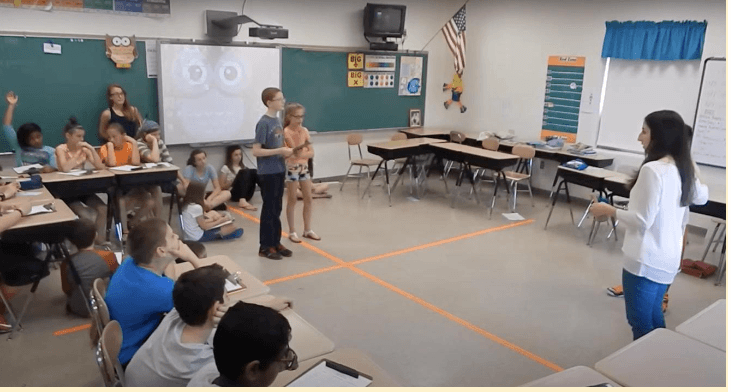
Fun math activity for middle school#4: Embed math into daily chores
If you’re teaching your middle schoolers household chores, incorporate some easy math activities into them.
Any chore can have a fun math element – for example:
Chore |
Learning |
| Laundry | Pairing socks can help with pattern recognition while loading the washer supports their understanding of spatial capacity. |
| Grocery shopping | Teaches currency and budgeting skills, as well as geometry and spatial awareness when filling the cart. |
| Putting away groceries | Helps kids to categorize types of food (i.e., freezer, fridge and pantry food). |
| Gardening | Incorporate fun math outdoor activities and help kids improve spatial awareness. |
Want to add a competitive math element to chores? Create a chore chart for your kid and allocate points to certain chores. The more difficult, the more points. Give your kids rewards when they reach certain points to keep them motivated.
If your kid is just starting to learn chores, be sure to supervise them to avoid any mishaps…
Fun math activity for middle school#5: Relate math to real-life scenarios
By this age, your kid will start using math in more real-life situations. Educational resources that teach them how to deal with these scenarios are an interesting and engaging way to learn about math in the real world.
Our Consumer Math worksheets give kids a stimulating way to apply mathematical concepts to real-world scenarios. They also allow kids to practice their skills.

That way, they’ll be confident when it comes to budgeting for groceries, paying taxes and much more in their short, medium and long-term futures.
Fun math activity for middle school#6: Challenge them to math-based word problems
Math-based word problems will be a recurring theme in your kid’s education. They’ll get more complex as your child moves up through the school grades.
The reason math-based word problems are so heavily embedded in education is because they illustrate how math is applied in the real world. From straightforward addition and subtraction problems to calculating the distances and speed of traveling objects, they’ll challenge your kids in an engaging way.
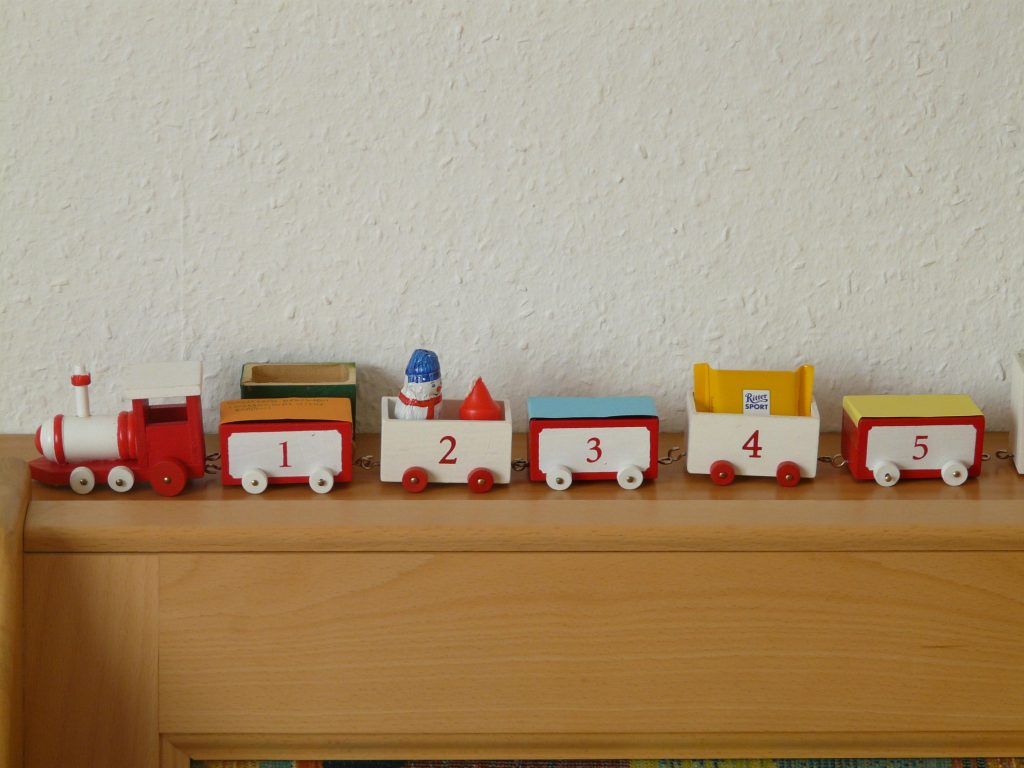
To make these math activities even more interesting, relate them to your kids’ favorite TV shows, movies, sports or hobbies. If your child loves trains, challenge them with train-based questions about speed and distance. Got a soccer-loving kid? Ask them to work out the ratios of women to men on a soccer team.
We have some great starter word math problem questions suitable for grades 1–8.
Fun math activities for high school
- Try out an escape room
- Play competitive quizzes
- Combine math learning activities with their favorite online games
- Teach them math jokes and puns
- Blend with their favorite subjects
- Engage them via their dream career
- Combine math with practical science
The best high school math activities are the ones that are both entertaining and challenging. Your kid is at a critical period in their education so boosting their learning will be super helpful.
Here’s our list of fun math activities for students in high school.
Fun math activity for high school#1: Try out an escape room
Learning in high school tends to be more desk-based than interactive. It can leave students bored. That’s why an escape room math activity can be so exciting!
Bring an element of fun back into your kids’ math learning activities and try out an interactive escape room. Use a blend of math-based puzzles to test out their skills.
You can combine this with a theme, such as a fairground or a movie theme, to make it feel less like work and more like play.
Just be sure the puzzles are solvable so they can escape…
Fun math activity for high school#2: Play competitive quizzes
A lot of high school sports and activities foster a competitive spirit. Make the most of that by hosting quizzes for high schoolers.
Whether you’re a parent hosting family quizzes or a teacher putting students to the test, it’s sure to bring out their competitive side.
There are so many ways you can put together a quiz, from interactive rounds to simple question-and-answer sessions. Mix up the format of your questions to keep it interesting.
You can up the stakes with a prize for the winner, too. That’s one way to make sure your kid commits to it! That’s why quizzes are one of the best high school math activities.
Fun math activity for high school#3: Combine math learning activities with their favorite online games
Is your teen addicted to Fortnite or Minecraft?
Allow them to enjoy their favorite game while learning with CodeWizardsHQ!
This online learning platform offers camps that teach your kids the mathematical skill of coding through their beloved PC games. It’s also a great way to make sure their screen time is positive and beneficial!
Fun math activity for high school#4: Teach them math jokes and puns
Songs can help younger kids to remember simple mathematical equations and concepts. As our kids get older and their understanding improves, we can incorporate puns and jokes into their learning.
Not sure where to start? We’ve put together a list of our top 100 favorite math jokes and puns!
Question |
Punchline |
| Why can’t you trust math teachers who use graph paper? | They’re always plotting something. |
| What’s a polygon’s favorite dinner? | Spaghetti and meat spheres! |
| Why was the fraction feeling incomplete? | It was missing its other half! |
| Why should you never talk to Pi? | It goes on forever. |
| Why was the math equation acting weird? | It must have been an odd function. |
Fun math activity for high school#5: Blend with their favorite subjects
Even if your kid doesn’t enjoy school, they’ll likely have a favorite subject.
Combine this with math to inspire enthusiasm in both subjects. This is especially useful if math is your kid’s least favorite subject!
Our math classes do just that – we use history, geography and scientific subjects to inspire kids to improve their math skills.

Our high school-grade lessons include studying ratios via tectonic plates, blending geometry with African history and culture and learning area, surface area and volume essentials through the lens of the industrial revolution.
Fun math activity for high school#6: Engage them via their dream career
By high school, your kids will start to develop ideas of what they want to do as a career. They may not have it fully formed yet, but you’ll start to see hobbies and interests solidify at this age.

If your kid wants to be a high-flying astronaut but doesn’t like math, it’s high time to explain to them its importance to that kind of job. Even the US’ future soccer superstars benefit from understanding velocity and angles!
Fun math activity for high school#7: Combine math with practical science
In high school, your kid will start to engage with more practical science experiments. It’s a great way to learn kinesthetically, and you can bring that to their math learning too.

An experiment as simple as growing bacteria in a petri dish can illustrate mathematical principles as well as scientific. It’ll bring to life just how exponentially bacteria will multiply – all while increasing their scientific curiosity too. Win-win!
This is great as a math enrichment activity during school holidays or as a weekend activity while they’re studying math and science.
Conclusion
So there you have it – a list of the most exciting and fun math activities! Just like the school curriculum, your math activities should get more complex as your kid progresses through school.
Remember that the most engaging math activities are the ones that relate to your kids’ interests while cementing their knowledge.

